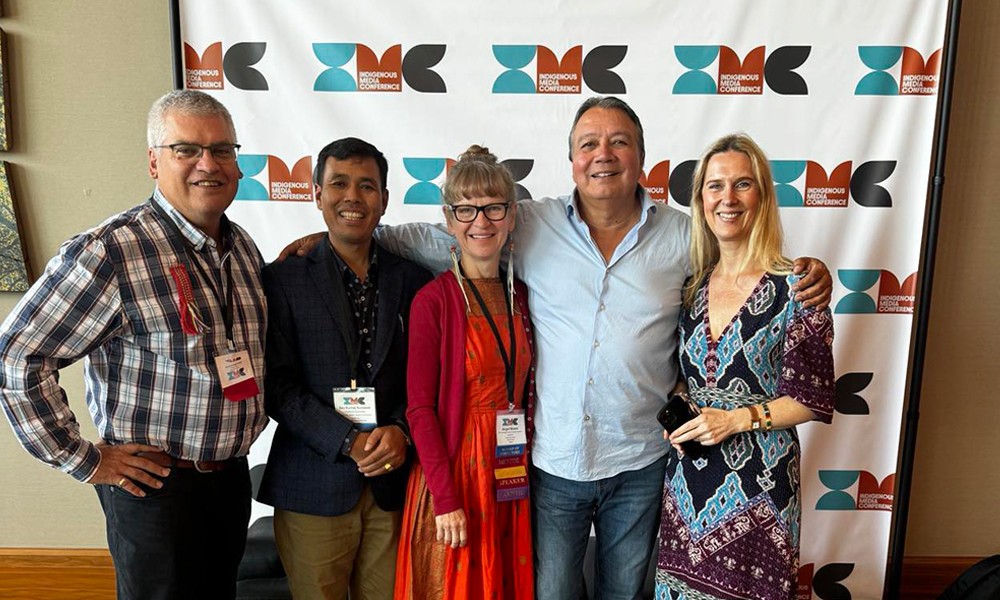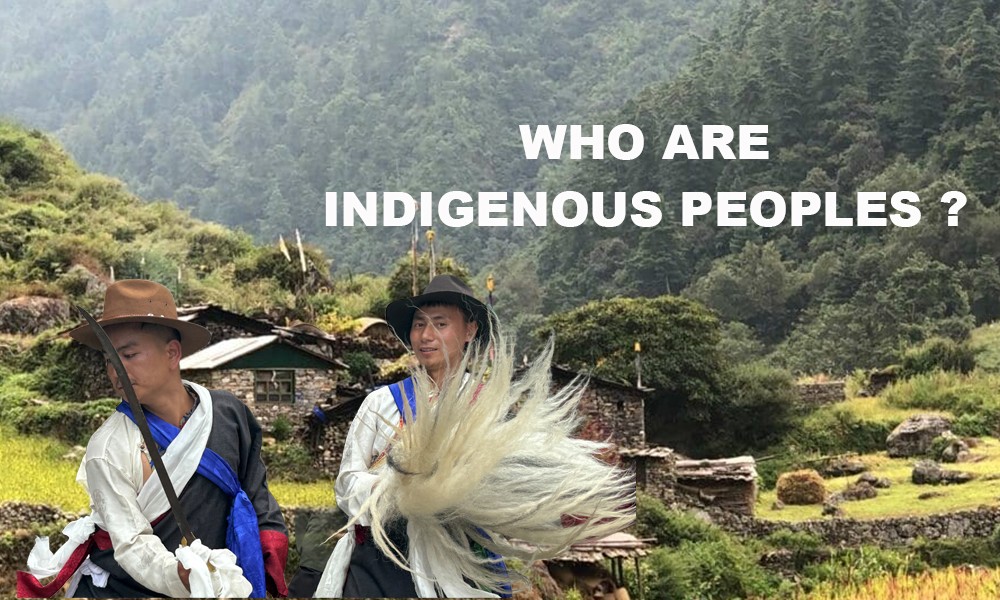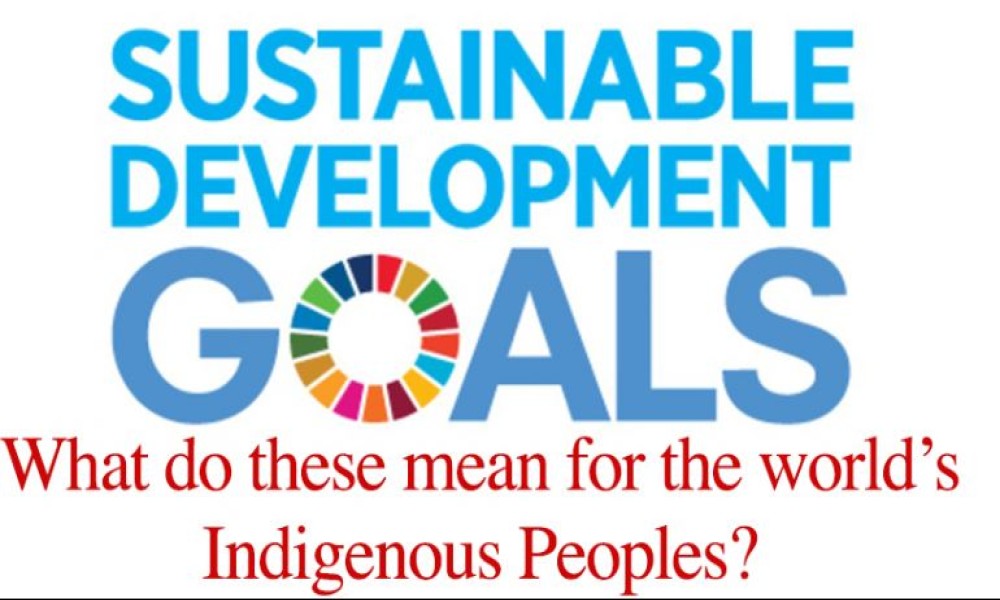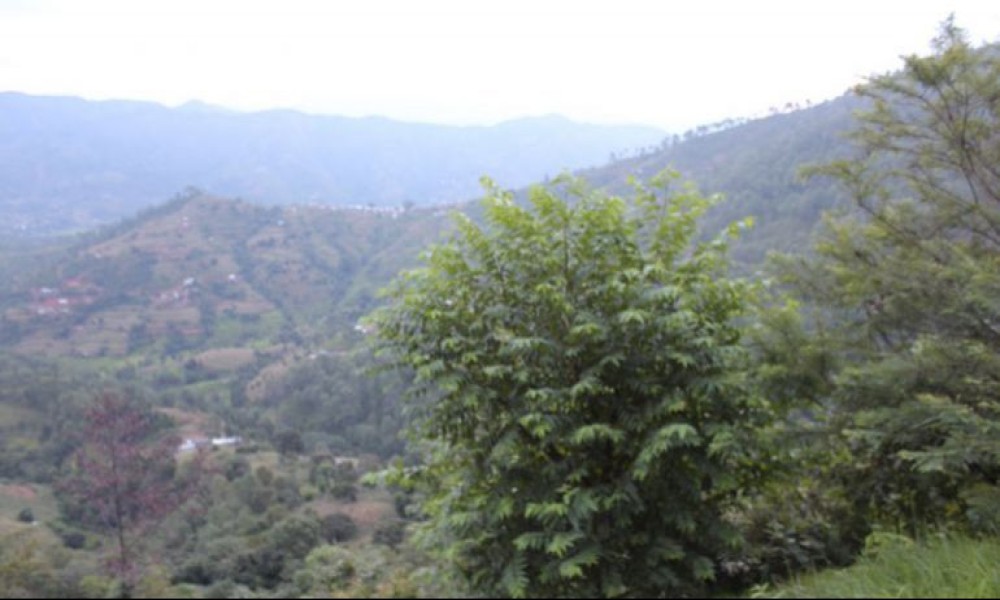As a journalist passionate about Indigenous issues and Indigenous media, attending the Indigenous Media Conference (IMC) 2024 was a transformative experience. The conference, held from July 25-27 in Oklahoma City, OK, was hosted by the Indigenous Journalists Association (IJA) and brought together nearly 500 Indigenous journalists, media professionals, and media experts worldwide. This three-day event provided valuable opportunities for learning, networking, celebrating contributions and achievements, and fostering a sense of unity and purpose. Representing Cultural Survival at this significant conference, I had the opportunity to witness global Indigenous journalists coming together to share their experiences, challenges, and successes in covering Indigenous communities, collaborating, and advocating for Indigenous rights.
One of the most impactful messages from the conference was the theme "Media for Indigenous Peoples: Towards a Global Response for the Implementation of Article 16 of the United Nations Declaration on the Rights of Indigenous Peoples (UNDRIP)." This key theme, jointly hosted by IJA and UNESCO, underscored the importance of Indigenous Peoples' right to media and the need to establish their media in their languages. It was inspiring to see the global Indigenous media community come together to discuss this critical issue and call for states to uphold this right. It was truly inspiring!
The Role of Indigenous Media
I found the session titled ‘How to survive and thrive away from mainstream media particularly resonant. As someone who has worked in both mainstream and Indigenous media, I was particularly interested in hearing from journalists who have successfully transitioned to independent and Indigenous-owned media outlets. The panel emphasized the importance of creative control and Indigenous sovereignty over storytelling, serving as a powerful reminder of why I chose this career path.
Frank Blanket (Yucatec Maya), award-winning Content Producer and director of Television for First Nations Experience, USA, emphasized the significance of Indigenous communities controlling their narratives. "It's important for us, as Indigenous communities, to be in charge of our narratives and the stories being told about us. Without that authenticity, we don't know how accurate those stories are," he stated, “Non-Indigenous media often tell stories from an outsider’s perspective, which can lead to sensationalism and a focus on negative or tragic stories. In contrast, Indigenous media strive to portray an authentic voice from Indigenous communities, telling their stories in a way that aligns with their perspectives.”
For instance, in the context of the climate crisis, Indigenous Peoples are often presented as victims. However, they are traditional ecological knowledge holders with solutions to climate challenges, such as addressing saltwater inundation in freshwater springs. Indigenous journalists are shifting the narrative from problem-focused to solutions-oriented reporting, highlighting the resilience and adaptability of their communities.
"It's important for us, as Indigenous communities, to be in charge of our narratives and the stories being told about us. Without that authenticity, we don't know how accurate those stories are," says, Frank Blanket (Yucatec Maya), award-winning Content Producer and director of Television for First Nations Experience, USA.
Lagipoiva Cherelle Jackson, Pacific Island Journalist and Climate Director at the Solutions Journalism Network, highlighted the importance of language in storytelling. "As a Samoan journalist, I know my audience and their problems. By speaking in our own languages and conducting interviews in local languages, we can delve deeper into local and traditional knowledge," she explained. Solutions journalism focuses on what is being done to build resilience and ensure survival beyond crises, and Indigenous journalists should honor the needs of their communities in their coverage.
Challenges and Opportunities
Ku’uwehi Hiraishi, a former reporter for Hawaii Public Radio, discussed the need for Indigenous media to control the narrative and present news that accurately represents Indigenous experiences. In Hawaii, for example, mainstream media have often painted an idyllic picture, overlooking the struggles and resilience of Native Hawaiians. Indigenous media must tell these stories from their unique perspectives to sustain their cultures and address contemporary challenges like climate change.
Journalism in some countries can be a dangerous profession, and Indigenous journalists often face significant risks. Frank Blanket noted the challenges Indigenous journalists face in the US, including harassment by authorities during protests and the need to inspire Native youth to tell their stories despite these dangers. Indigenous communities worldwide share common struggles, such as dispossession of land and occupation without free, prior, and informed consent. The conference emphasized the importance of coming together to collectively celebrate each community's indigeneity and address these issues.
Press Freedom and Media Sovereignty
One of the prominent themes at the conference was the challenge of press freedom. Speakers emphasized the importance of creative control and Indigenous sovereignty over storytelling. Indigenous Peoples have established media organizations, including radio, television, newspapers, and online platforms, to amplify their voices and tell their stories. However, these efforts often face financial and systemic challenges.
Jodi Rave Spotted Bear (Mandan, Hidatsa, and Arikara Nation/Lakota), the Board Member of IJA and founder and director of the Indigenous Media Freedom Alliance, highlighted the need for local media outlets to preserve Indigenous languages and cultures. "If we're not telling our stories, who will tell those stories? We need local media outlets to overcome news deserts in Indigenous and minority communities," she said.
The landscape of indigenous media in the United States is vast and varied, with over 500 federally recognized tribes and hundreds of tribal news outlets. However, the level of press freedom across these outlets is inconsistent, ranging from complete editorial independence to almost none.
Bryan Pollard (Cherokee), the former executive editor of the Cherokee Phoenix and Grant Operation Manager at Associated Press, highlights a fundamental challenge: financial independence. Many indigenous media outlets are small, with limited audiences and remote locations, making it difficult to generate revenue through advertising or other traditional means. This often leads to reliance on tribal governments for subsidies, creating a conflict of interest that can compromise editorial integrity.
"When the government basically pays to run the media outlet, the government then thinks it has control over the message and coverage of the outlet," explains, Bryan Pollard (Cherokee), the former executive editor of the Cherokee Phoenix and Grant Operation Manager at Associated Press.
"When the government basically pays to run the media outlet, the government then thinks it has control over the message and coverage of the outlet," Pollard explains. This financial dependency is a significant barrier to achieving and maintaining press freedom in Indian Country.
However, there is hope. Pollard and other advocates are exploring solutions, including international collaborations and partnerships with mainstream newsrooms. By sharing resources and expertise, smaller outlets can benefit from the greater capacity of larger organizations, while mainstream outlets can gain a deeper understanding of Indigenous communities and their stories.
Collaboration, however, requires careful navigation. Pollard emphasizes the importance of cultural sensitivity and understanding when partnering with mainstream outlets. "We've seen examples where Indigenous media have attempted to collaborate with mainstream media, and it has just gone wrong because the mainstream outlet just does not understand the sensibilities that are necessary to be able to effectively collaborate and tell Indigenous stories," he cautions, further stressed the need for sustainable funding and international collaborations to enhance the capacity and distribution of Indigenous media.
Pressures and Threats
Indigenous journalists in Canada and the United States are increasingly facing threats to their press freedom, including police violence, government control, and public hostility. Angel Ellis (Muscogee Creek), the Chair of the Press Freedom Committee at IJA, noted that Indigenous journalists are more susceptible to police violence and negative interactions with law enforcement. Policies in nations like the US and Canada, where press freedoms are deteriorating, are exacerbating this trend.
"A lot of the indigenous peoples are living in situations where they have to defend land or water and the rights of indigenous people," Ellis said. "So the journalists who are covering those topics are more likely to experience police violence and government controls, and they're more likely to have their press freedoms suppressed."
This is due in part to the marginalization of indigenous communities and their close connection to natural resources, which often puts them in conflict with government and corporate interests. As a result, law enforcement and the general public frequently view Indigenous journalists who cover these issues as a threat and target them.Ellis also stressed the importance of journalists knowing their rights, having a plan in case of arrest, and ensuring that their stories are published even if they are detained. "We need to think, it's not if we're arrested, but when we're arrested," Ellis said. "And we need to plan for that event very specifically."
"A lot of the indigenous peoples are living in situations where they have to defend land or water and the rights of indigenous people," Angel Ellis (Muscogee Creek), the Chair of the Press Freedom Committee at IJA said. "So the journalists who are covering those topics are more likely to experience police violence and government controls, and they're more likely to have their press freedoms suppressed."
Despite the challenges, Ellis remains optimistic about the future of indigenous journalism. She encouraged journalists to continue educating themselves, build networks of support, and remain committed to their mission of informing the public. "It's very important that we continue to educate ourselves on these changing policies," Ellis said. "And I want to encourage all journalists, whether they're indigenous or not, to plug into networks of support."
The conference’s focus on practical skills and resources for Indigenous journalists was also valuable. The conference also focused on a series of engaging sessions, which included sessions on accessing government records, reporting on tribal businesses and economics, navigating federal courts, fighting election misinformation, and providing valuable tools and knowledge to report on Indigenous issues effectively. Other sessions addressed funding opportunities for journalists, climate change, investigative journalism, and mental health in the workplace; also was a brainstorming session on IndigiQueer Coverage in Indian Country and a mixer for alumni of the Native American Journalism Fellowship, and Indigenous Journalism Fellowships, highlighting the unique challenges and opportunities faced by Indigenous journalists.
Another inspiring aspect of the conference was connecting with other Indigenous Journalists and media professionals. A vibrant Indigenous Media Expo showcased the work of Indigenous Journalists, was a bustling hub of networking and collaboration, and provided a space for journalists to meet editors, share experiences, and reconnect with colleagues. The conference emphasized the importance of community and collaboration in advancing Indigenous rights and issues. The IJA President’s Reception and the Indigenous Media Awards Banquet provided further opportunities to celebrate Indigenous Journalists' accomplishments and strengthen community bonds.
Realizing Article 16 of UNDRIP
Article 16 of UNDRIP guarantees Indigenous Peoples the right to establish their own media. However, revitalizing and preserving Indigenous languages are critical to realizing this right. Governments that have contributed to the erosion of Indigenous languages must invest in programs to save and promote these languages. Media and Indigenous journalism play a crucial role in this process, though their importance is often overlooked.
Jodi Rave Spotted Bear (Mandan, Hidatsa, and Arikara Nation/Lakota) stressed the need for adequate investment in Indigenous language journalism, radio, television, and other media content production. Establishing Indigenous journalism schools is essential to train new generations of storytellers. Despite creating platforms to tell their stories, Indigenous communities often lack direct funding and resources to sustain their media efforts. Systemic issues and government policies further complicate these efforts.
Jim Compton (Anishinaabe, Keeseekoose First Nation), an Indigenous filmmaker in Canada and founder of the Aboriginal Peoples Television Network, emphasized the need for governments to acknowledge and support Indigenous media. "We need to have the power of story to change and affect government and maintain our cultures and languages," he said. Article 16 of UNDRIP is vital for ensuring Indigenous voices are heard and their stories are told from their perspectives.
Throughout the Indigenous Media Conference 2024, I was struck by and powerfully reminded of the passion, resilience, and determination of Indigenous journalists to tell their own stories and hold those in power accountable. The conference provided a much-needed space for global Indigenous voices to be heard and for Indigenous perspectives to be shared. It was an honor to be part of this gathering and witness the power of Indigenous media to shape narratives and create positive change.
As I reflect on my experience at the IMC 2024, I am filled with a renewed sense of purpose and a deeper appreciation for the vital role of Indigenous journalism in amplifying Indigenous voices and perspectives. The conference was a valuable learning experience and a reminder of the importance of community and collaboration in advancing Indigenous rights and issues.










